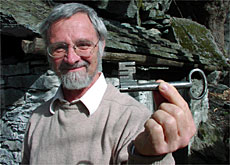A valley’s future lies in the Stone Age

The picturesque Vallemaggia (Maggia Valley) in canton Ticino has set its new image in stone.
The “Pietraviva” (Living Stone) project is a new marketing concept exploring the valley’s long dependence on the element as a building material.
A network of grottoes concealed under a prehistoric rockslide behind the village of Cevio is one of the highlights.
If you know where to look, you can make out the rockslide from the road, but the caves constructed under the fallen boulders remain hidden from view (see video).
“The grottoes were first built thousands of years ago, but it is quite unique that they were still being used up until the Second World War,” explains Bruno Donati as he unlocks a door to one of the caves.
These cool spaces sealed with manmade stonewalls and heavy wooden doors are empty now, but Donati – a schoolteacher who runs the valley museum – says people once stored their entire harvest in them: cheese, maize, chestnuts and wine.
Key to life
“A local saying that ‘you should possess the grotto key once in your life’ is a way of wishing someone luck because the most important thing is to have enough food to live on,” Donati continues.
Discovering the caves of Cevio is a must for visitors to this beautiful valley where stone still plays an important role in the lives of local people.
The Pietraviva project grew out of the locals’ desire to improve Vallemaggia’s potential as a tourist destination and promote its cottage industries.
“We aren’t living in the Stone Age anymore, but we have benefited from local stone as a building material, and we have also benefited culturally,” says project leader, Giovanni Do.
“It’s been an essential element in our lives for centuries, even millennia, and we continue to use it. We have a relationship with stone that can’t be severed.”
Stone tile roofs
You cannot help but admire the tastefully restored houses in many villages, topped with stone tile roofs.
The village of Peccia is home to Switzerland’s only marble quarry and the valley’s school of sculpture offering courses for beginners and advanced students.
A little further up the twisting mountain road is the hamlet of Mogno where Ticino’s star architect, Mario Botta, has constructed an elliptically shaped chapel from Peccia marble and granite from the Bettazza quarry outside Cevio.
“It’s hard to find the same shade of grey, the same structure in the stone anywhere else in the world,” says Mauro Bettazza, explaining the unique qualities of his granite.
Bettazza exports nearly all of the 20,000 cubic metres the family-run operation quarries each year, even though the company cannot compete on price in the global marketplace.
Handcrafted
He also employs craftsmen who cut blocks of gneiss rock into thin slabs by hand, a practice, he says, which has become rare, but allows the cut stone to retain a natural surface.
“Stone has formed the landscape here, and it forced the people to adapt their lives accordingly,” Do says.
The local tourist office has published informative Pietraviva leaflets (in Italian and German) with suggested hiking routes through the valley’s bucolic villages.
For the first time, it offers visitors a chance to better understand how people once lived in this secluded part of the Alps, and how they cope today.
In conjunction with Pietraviva, the tourist office is also putting together a list of traditional stone farmhouses which can be hired out to holidaymakers wishing to make new discoveries.
“It’s important to learn from our past but to continue to work with stone today,” Do concludes.
“We want to use it as a symbol of Vallemaggia in the outside world.”
swissinfo, Dale Bechtel in the Vallemaggia
The Vallemaggia runs northwest from near the lakeside town of Locarno.
Locarno, with a wide variety of accommodation, can be used as a base to explore the valley.
Vallemaggia’s administrative capital is Cevio, a picturesque village with a few small inns and holiday rental properties.
The Pietraviva project is a local initiative to promote the valley’s tourist attractions and cottage industries.
It highlights the valley’s traditional and modern stone architecture, quarries and stone crafts.
Among the highlights is the elliptically shaped chapel in Mogno designed by Ticino architect Mario Botta and the dozens of grottoes outside Cevio.
A just completed study uncovered 1,600 such grottoes across the Maggia valley.

In compliance with the JTI standards
More: SWI swissinfo.ch certified by the Journalism Trust Initiative











You can find an overview of ongoing debates with our journalists here . Please join us!
If you want to start a conversation about a topic raised in this article or want to report factual errors, email us at english@swissinfo.ch.